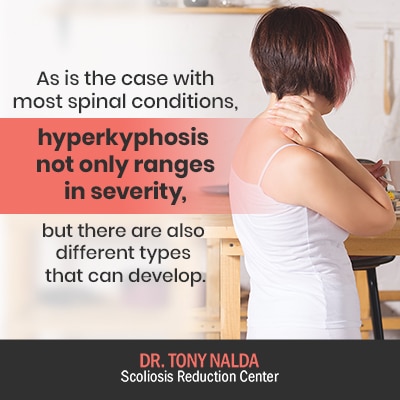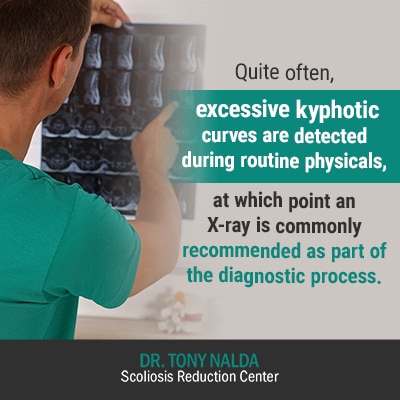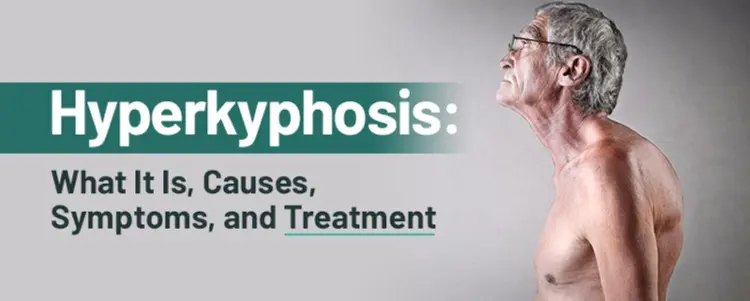A healthy spine provides the body with structure, balance, allows us to stand upright, practice good posture, and facilitates movement. For a spine to function optimally, it has to maintain its natural curvatures and alignment. Spinal conditions that involve a loss of the spine’s healthy curves can impact its overall health and function. Keep reading to find out how spinal conditions like hyperkyphosis can also lead to postural changes, giving a ‘roundback’ appearance.
The spine has healthy curvatures that bend inwards, towards the body’s center, and outwards, away from it. ‘Kyphosis’ refers to the inward spinal curvature of the thoracic spine. ‘Hyperkyphosis’ develops when the kyphotic curve becomes excessive, leading to a rounded appearance of the upper back.
Before moving on to the specifics of hyperkyphosis, including causes, symptoms, and treatment, let’s first explore some basic spinal anatomy for a better understanding of how conditions like hyperkyphosis affect the spine.
4 Key Takeaways
- Essential Spinal Health: The spine’s optimal function depends on maintaining its natural curvatures. Hyperkyphosis, characterized by an excessive inward curve of the thoracic spine, disrupts this balance, leading to a “roundback” appearance and impacting overall health and function.
- Types of Hyperkyphosis: Hyperkyphosis manifests in various forms, including postural, congenital, and Scheuermann’s kyphosis. Each type originates from different causes and presents distinct challenges, necessitating tailored treatment approaches.
- Treatment Approaches: Effective hyperkyphosis treatment is multifaceted, incorporating exercises, therapy, and, when necessary, corrective bracing. Treatment aims to address both the curvature and any associated symptoms, enhancing posture and reducing discomfort.
- Proactive and Integrative Care: Early detection and a proactive treatment strategy are critical, especially for children and adolescents. Integrating various therapeutic disciplines offers the best chance for structural correction, improving quality of life while managing hyperkyphosis.
Understanding Spinal Anatomy
The spine is made up of three main sections: cervical, thoracic, and lumbar. When viewed from the front or back, the spine appears straight, and when viewed from the side, it has a soft ‘S’ shape.
Each section of the spine has a characteristic curvature, some that bend inwards, towards the center of the body, and some that bend outwards, away from the body’s center.
The natural curves of the cervical spine (neck) and lumbar spine (lower back) bend outwards and are referred to as ‘lordosis’. The thoracic spine (middle and upper back) features a curve that bends inwards, and this type of curve is referred to as ‘kyphosis’.
As mentioned, the spine’s natural and healthy curves allow it to function optimally; they help us maintain balance and good posture, stand upright, make the spine stronger, more flexible, and facilitate its even distribution of weight and stress that’s incurred during movement.
So what happens if one of the spine’s natural curvatures becomes over-pronounced? If a healthy spinal curve is compromised and turns into an unnatural one, it disrupts the spine’s overall biomechanics, and this is why changes to posture are one of the telltale signs that a spinal condition has developed, including hyperkyphosis.
So now that we have talked about the spine’s main sections and corresponding healthy curves, let’s move on to discuss some of its important individual components, such as its vertebrae and intervertebral discs.
The Vertebrae and Discs of the Spine
The spine is made up of individual bones called ‘vertebrae’, and in a healthy spine, they are rectangular in shape and stacked on top of one another in a straight, neutral, and healthy alignment.
The vertebrae are connected by intervertebral discs that sit between them, giving the spine structure.
The discs of the spine have tough and durable outer layers and soft gel-like interiors. They perform many important roles, including providing cushioning so the vertebrae don’t rub up against each other and generate friction during movement.
They also help facilitate spinal flexibility and act as the body’s shock absorbers so stress is evenly distributed throughout and no one section of the spine is exposed to uneven wear.
The intervertebral discs help the spine maintain its natural and healthy alignment, which allows it to function optimally; however, when a spinal condition develops that impacts the health of its individual parts, such as the vertebrae and/or its intervertebral discs, the spine’s natural alignment can be disrupted and lead to the development of an unnatural curvature, such as hyperkyphosis.
The Spine’s Natural Kyphosis and Hyperkyphosis
As mentioned, the thoracic spine features a natural kyphotic curve, and a healthy kyphosis would fall into the range of between 20 and 45 degrees, but when a curve falls beyond that healthy range, problems can occur.
When a kyphotic curve exceeds 50 degrees, this is referred to as ‘hyperkyphosis’, also commonly referred to simply as ‘kyphosis’, and this means the thoracic spine’s natural forward curvature is over-pronounced, and commonly, this gives the upper back an excessively rounded-forward appearance, known as ‘roundback’.
Hyperkyphosis can develop at any age, but is most commonly diagnosed in adolescents; this is understood as a result of puberty and its growth spurts that include rapid bone growth.
Kyphosis can range in severity from mild to severe, and while every case is different, generally, the larger the kyphosis, the worse the condition is and the more potential it has to disrupt a person’s posture, the spine’s overall health and function, and cause problems in the future, especially if left untreated.
So the main symptoms of hyperkyphosis include postural changes such as an excessively-rounded upper back and shoulders, and varying levels of pain.
Minor kyphotic curves tend to cause only mild back pain, if any, and often don’t produce noticeable postural changes; with larger kyphotic curves, however, symptoms can include back and muscle pain, and noticeable postural symptoms such as a visible arch on the upper back, causing a ‘roundback’ appearance.
Also, it’s important to clarify that pain is not a common symptom of hyperkyphosis in children and adolescents, but can be in adults; this is understood as a result of growth and skeletal maturity.
In adults whose spines have settled due to gravity and maturity, the spines are vulnerable to compression caused by unnatural spinal curves, felt not only in the spine itself, but also in its surrounding muscles and nerves.

As is the case with most spinal conditions, hyperkyphosis not only ranges in severity, but there are also different types that can develop.
Three Common Types of Hyperkyphosis
As mentioned, there are different forms of hyperkyphosis, and the three most common mainly affect children and adolescents: postural, congenital, and Scheuermann’s.
As postural is the most common, we’ll start there.
Postural Kyphosis
Postural kyphosis is the most common type and generally becomes noticeable during the adolescent years. It commonly presents as overall poor posture, particularly with slouching.
This type is the simplest to treat as it is not a structural condition, and is instead related to body positioning, which is why it’s not permanent.
A change in position and active effort to stand up straighter can correct the unnatural kyphosis as the postural issues are addressed.
This type is more commonly found in girls, is rarely painful, and is not progressive.
Congenital Kyphosis
With congenital kyphosis, infants are born with the condition as it develops in utero due to a malformation within the spinal column itself.
Malformations can include vertebrae not forming properly, or multiple vertebrae fusing together into one solid bone, rather than forming separate and distinct vertebrae.
While every case is different, congenital kyphosis generally progresses with growth.
Scheuermann’s Kyphosis
Scheuermann’s Kyphosis is a structural condition, which makes it more serious and difficult to treat than postural kyphosis, and if left untreated, is likely to cause problems down the road.
This type of kyphosis is also most commonly diagnosed during adolescence and tends to be easier to spot in people with less body fat.
As Scheuermann’s kyphosis is structural in nature, this means it involves a structural abnormality within the spine itself, such as misshapen vertebrae that impair the spine’s ability to maintain its natural and healthy curvatures.
Healthy vertebrae are rectangular in shape, and in patients with Scheuermann’s kyphosis, X-ray images taken from the side will reveal a number of consecutive vertebrae to be triangular in shape.
Being triangular, instead of rectangular, means the vertebrae’s ability to remain stacked on top of one another in a healthy alignment is compromised as they become wedged together towards the front of the spine.
When the wedging of misshapen vertebrae occurs, it can cause a loss of disc space and an exaggerated forward curvature of the spine in the area affected, which is most often the upper region of the thoracic spine, although it can also affect the lumbar spine.
Abnormal spinal curvatures caused by this type of kyphosis are often angular, stiff, sharp, and rigid, which is why this form is more complex to treat and can’t simply be corrected with a change of position.
This type is more common in boys and is progressive during growth, which is why proactive treatment is so important, and while it can be painful, as the condition is most commonly found in children and adolescents who have not yet reached skeletal maturity, pain is not a common symptom for younger patients.
For adults with Scheuermann’s kyphosis, it’s more frequently painful, and pain tends to be concentrated at the site of the most-tilted vertebrae: the curvature’s apex.
In addition, when the spine responds to an excessive kyphotic curve of the upper back by putting a compensatory curve in the lower back, this can also cause back pain in the lumbar spine.
Pain also tends to worsen for adults during movement or long periods of sitting/standing.
So how does a person know they have hyperkyphosis? What are the most common symptoms and telltale signs of the condition?
It’s important to know the signs to look for as there are many benefits associated with early detection and proactive treatment applied as close to the time of diagnosis as possible.
Symptoms of Hyperkyphosis
Every case of hyperkyphosis is different and will produce its own unique set of signs and symptoms based on important patient/condition characteristics such as age, condition severity, and condition type.
Following are some signs and symptoms of an excessive kyphotic curve:
- Excessively-rounded shoulders
- A visible arch on the back
- Back pain (in adults)
- A stiff and rigid spine
- Tight hamstring muscles
- General fatigue
- In severe cases, issues with organs such as the lungs and heart
Again, pain is not a common symptom in children and adolescents because growing spines are less vulnerable to compression, but for adults whose spines are no longer growing, their spines, along with surrounding muscles and nerves, are subject to compression, and this can cause varying levels of pain.

Quite often, excessive kyphotic curves are detected during routine physicals, at which point an X-ray is often recommended as part of the diagnostic process.
So if you have received a kyphosis/hyperkyphosis diagnosis, what’s next?
Treatment for Hyperkyphosis
As discussed, there are different types of hyperkyphosis, the most common being postural, congenital, and Scheuermann’s.
As every case is different and will have its own unique treatment needs, this is why, here at the Scoliosis Reduction Center®, I customize each and every treatment plan to address specific patient/condition characteristics.
As hyperkyphosis most commonly affects children and adolescents facing unpredictable and rapid growth spurts during puberty, one of the main goals of proactive treatment is to stop the abnormal spinal curvature from progressing and preventing related postural changes and increasing symptoms.
Although it most commonly affects younger people, adults can develop hyperkyphosis as well, particularly as aging can cause spinal degeneration that impairs the spine’s ability to maintain its healthy curvatures and alignment.
When crafting treatment plans for hyperkyphosis patients, I factor in important variables such as patient age, overall health, level of spinal flexibility, and how much growth, if any, they have yet to go through; in addition, condition severity and type are important factors that guide the treatment approach moving forward.
Treatment for Postural Kyphosis
As mentioned, postural kyphosis is the most common type, and this is also the easiest to treat because it is not a structural condition.
For this type of kyphosis, therapy and exercise and common forms of treatment as they address the postural issues that are causing the kyphosis.
In most cases, because it is not structural, once bad postural habits are addressed, such as standing up straighter and doing exercises that encourage better body positioning, the underlying cause of the kyphosis is addressed and the excessive kyphotic curvature can be corrected.
Treatment for Congenital Kyphosis
Treatment for congenital kyphosis has to, first and foremost, impact the condition on a structural level because this type is caused by a structural abnormality within the spine itself, such as misshapen vertebrae.
Monitoring is also an important facet of treatment to determine patients’ progressive rates; this is achieved through physical examinations and X-rays, when needed.
Monitoring doesn’t just involve watching for progression, but also assessing how the spine is responding to treatment and adjusting treatment plans accordingly in response.
While treating infants and young children does come with its own unique set of challenges, it is possible to comprehensively modify treatment plans designed for older children and adolescents: making them effective at addressing the specifics of congenital kyphosis in infants and young children.
The severity of each individual case will be the driving force behind treatment as modifications to kyphosis-specific therapy and/or corrective bracing can be applied accordingly to address progressive rates and work towards reducing the curvature on a structural level.
Treatment for Scheuermann’s Kyphosis
As mentioned, Scheuermann’s kyphosis is structural in nature, meaning that any effective form of treatment has to impact the condition on a structural level.
As the severity of these cases vary greatly, treatment needs also vary, but in general, initial observation is the first step of treatment to help determine whether or not a patient’s condition is progressing, and if so, at what rate.
Monitoring for progression plays a more important role in the treatment of children and adolescents as they are facing growth, which is the main trigger for progression in a number of spinal conditions, including Scheuermann’s kyphosis.
The monitoring aspect of treatment involves periodic physical examinations and X-rays, when needed, scheduled at predetermined intervals; this will help determine a patient’s progressive rate and treatment needs.
While monitoring is an important part of treatment here at the Center, it is accompanied by proactive treatment, which is key, because passively observing while a spinal condition progresses unimpeded is wasting valuable treatment time.
While there are never treatment guarantees, early detection and proactive treatment can increase chances of treatment success. I offer patients an integrative approach that combines multiple treatment disciplines for the best results; treatment can include in-office therapy, featuring kyphosis-specific exercises that address any related symptoms like pain (more common in adults), and working towards improving changes to posture, such as the rounding-forward of the upper back, and increasing core strength.
Increasing core strength is important because it’s not just the individual components of the spine itself that maintain its natural curves and alignment, but also its surrounding muscles that provide it with support and stabilization.
In addition, making the back and abdomen stronger can take pressure off the spine, which also helps with better support and stabilization.
Through a combination of specialized custom-prescribed exercises, stretches, therapies, and corrective bracing, when needed, kyphosis-related pain can be eased by keeping the spine and its surrounding muscles as loose and flexible as possible.
Here at the Center, we also have a traction chair that uses vibrations to help relax important muscles and, over time, can aid in the restoration of natural spinal curvatures of the upper back and neck.
I also use highly-specialized cantilevers and weights that can help work towards a more balanced, neutral, and natural posture and body positioning.
While corrections are not always guaranteed, quick and/or easy to achieve, through the crafting of a comprehensive customized treatment plan, commitment, and hard work, they are indeed possible.
Particularly in younger patients who have not yet reached skeletal maturity, initiating treatment as close to the time of diagnosis as possible is essential as it’s much easier to treat an abnormal spinal curvature while it is still small, less rigid, and before the body has had time to adjust to its presence.
Conclusion
The spine can develop a number of conditions that impact its overall health and function, hyperkyphosis being one of them.
As the spine is naturally curved to give it increased strength, flexibility, and allows it to evenly distribute stress, a loss of its natural curvatures can lead to a number of problems.
The term ‘kyphosis’ refers to spinal curvatures that bend inwards, towards the body’s center, and it is also used, along with the term ‘hyperkyphosis’, to refer to conditions that involve an excessive kyphotic curve.
The three most common types of hyperkyphosis are postural, congenital, and Scheuermann’s, each form with its own unique treatment needs.
Here at the Scoliosis Reduction Center®, patients have access to a number of treatment disciplines including kyphosis-specific chiropractic care, in-office therapy, custom-prescribed home exercises, and corrective bracing; together, these different treatment modalities can be combined, working towards a correction on a structural level so the condition’s underlying cause is addressed.





